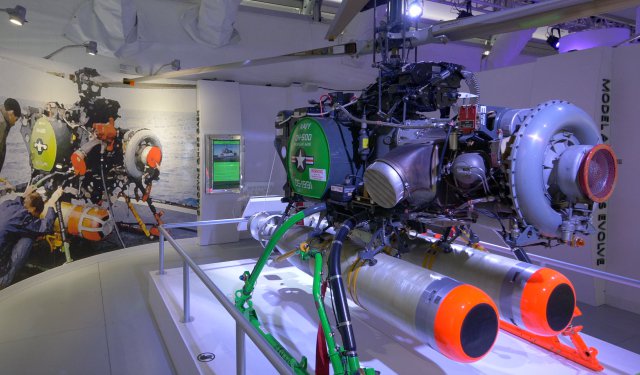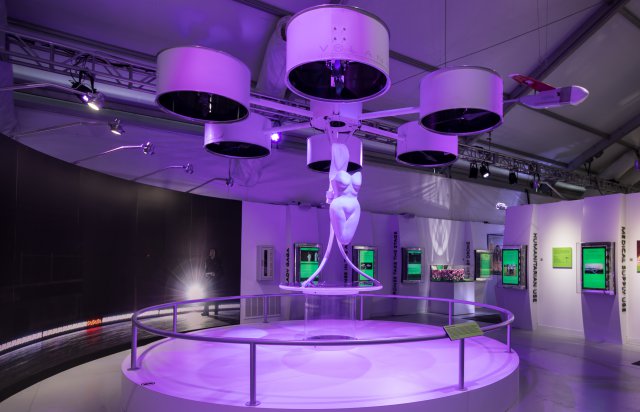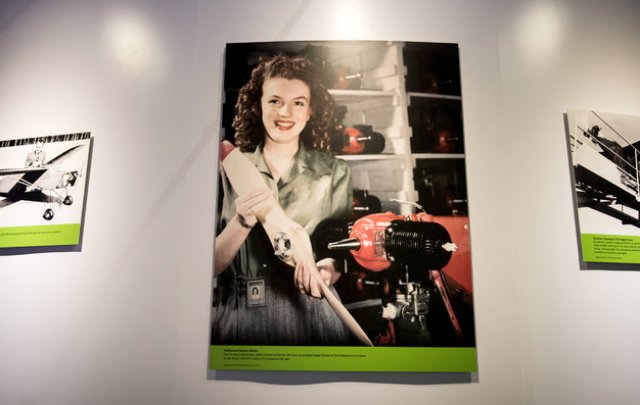
Drones: Is the Sky the Limit?, the first major museum exhibition on pilotless aircraft, often called unmanned aerial vehicles (UAVs), will open at the Intrepid Sea, Air & Space Museum in New York City on Wednesday, May 10. The large-scale exhibition, which will be located in a 6,000-square-foot custom-designed pavilion on the Museum’s Pier 86, will explore the history of drone technology, from its modern origins in World War I and its military development to its current applications in solving complex humanitarian and commercial challenges. The exhibition will be open through December 3, 2017.
Drones: Is the Sky the Limit? will showcase authentic drones, interactive experiences, historical artifacts, model airplanes, rare videos and immersive installations that will engage visitors as they explore the early attempts to employ unmanned flying machines to the advanced systems of the 21st century and beyond.
A unique blend of small and large-scale artifacts all tied to the technology and uses of pilotless aircraft will be featured in the exhibition, including military and commercial drones. Highlights include Volantis, the world’s first “flying dress” on display to the public for the first time, designed by global superstar Lady Gaga, in collaboration with the technology development division of her Haus of Gaga (known as TechHaus), and Studio XO.

Plus a prototype of an Amazon cargo vehicle designed for home delivery of online shopping orders; and human-carrying vehicles represented by a full-scale conceptual aircraft that may become the personal autonomous transportation system of the future.
Visitors will be able to fly actual drones, watch the dizzying first-person viewpoint of a drone racing; explore the use of drones in police and fire departments; see how drone technology creates new perspectives for photographers, artists, filmmakers and stage productions; explore the implications of pilotless aircraft on industries including infrastructure, agriculture and meteorology; learn about its contributions to conservation and humanitarian efforts; and consider what the future holds – from the possibility of personal flying cars to space exploration.
The exhibition will also feature archival and contemporary photographs, artist renderings that offer a glimpse of the future of drone technology, and an “immersion” theater where visitors will experience dramatic images captured by the unique cinematographic perspective of the drone.
“The advancement of pilotless aircraft over the past few decades is truly astonishing,” said Susan Marenoff-Zausner, president of the Intrepid Museum. “This exhibition showcases the far-reaching impact of drones on countless human endeavors—from wildlife conservation and space exploration to artistic expression and our daily lives. Drones: Is the Sky the Limit? gives visitors amazing insight into how far we have come and how this technology will shape the future.”
“In 1903 with the Wright brothers’ first flight at Kitty Hawk, people were fascinated with the idea of simply sharing the sky with birds. In just a little more than 100 years, we are again capturing this spirit of aviation adventure by harnessing pilotless aircraft to augment humans in ways never envisioned by the Wright brothers,” stated Dr. Mary L. “Missy” Cummings, co-curator of the exhibition. “This exhibit truly captures our new transformative golden age of aviation, and will leave visitors amazed and excited by the future of autonomous flight.”
The Intrepid Museum will offer related programs for students, educators and the general public that explore this growing technology and its controversial and ethical implications. Programs will incorporate lively dialogue, demonstrations of drones in flight, installations and social gaming.
Drones: Is the Sky the Limit? is co-curated by Eric Boehm, the Intrepid Museum’s curator of aviation, along with Dr. Mary L. “Missy” Cummings and Dr. Alexander J. Stimpson, of Duke University and Autonometrics, LLC. Cummings was one of the Navy’s first female fighter pilots, serving with the Navy from 1988 to 1999. She is now the director of Duke Robotics and Duke’s Humans and Autonomy Lab. Stimpson is a research scientist in the Department of Mechanical Engineering and Materials Science at Duke University. Both are partners with Autonometrics, and specialize in human interaction with autonomous systems, particularly applications of autonomous transportation systems including drones and flying cars.
The drone pictured in the 1945 photograph aboard the Intrepid was a TDD, which stands for Target Drone, Denny, and it had a Hollywood connection. Denny was named for Reginald Denny, a suave English leading man during the silent era and, later, a reliable silver-haired uncle in the talkies. Like many others inspired by the feats of Lindbergh and Earhart, he had become a model-airplane hobbyist. He opened a hobby shop and created the Radioplane Company to manufacture model airplanes and engines.
In 1940, Denny won an Army contract to produce radio planes as target drones for military use, and at this point, Ronald Reagan enters the picture. As captain at the head of a motion picture unit popularly known as the Celluloid Commandos, and a friend of Denny’s, he sent Pvt. David Conover to take some routine pictures of civilians doing war work at the Radioplane plant in Culver City, Calif.
Private Conover trained his lens on a 19-year-old assembler, Norma Jeane Dougherty, who posed, holding a propeller and flashing a million-dollar smile. He told her she was photogenic and should consider a career in modelling.

Norma Jeane Dougherty, later known as Marilyn Monroe, at work on an OQ-2 Radioplane. Credit Mark Kauzlarich for The New York Times
Exhibition collaborators include Arthur Holland Michel and Dan Gettinger, co-directors of the Center for the Study of the Drone at Bard College. They lead an interdisciplinary research institution that conducts original research on the novel and complex opportunities and challenges presented by unmanned technologies in the military and civilian spheres.
Drones: Is the Sky the Limit? is made possible by DJI, the American Institute of Aeronautics and Astronautics, and the Institute of Electrical and Electronics Engineers.
This exhibition is also supported in part by public funds from the New York State Council on the Arts, with the support of Governor Cuomo and the New York State Legislature.
Programs presented in conjunction with Drones: Is the Sky the Limit? are made possible by The Rose M. Badgeley Residuary Charitable Trust, The Barker Welfare Foundation, the Consolidated Edison Company of New York, The FAR Fund, the International Society of Transport Aircraft Trading, The Ambrose Monell Foundation, the May and Samuel Rudin Family Foundation, and The Joseph LeRoy and Ann C. Warner Fund. Select programs are presented in collaboration with the IEEE History Center and the New York Chapter of the IEEE.
This exhibition is also supported in part by public funds from the New York City Department of Cultural Affairs in partnership with the City Council.
Drones: Is the Sky the Limit? is free with the price of admission to the Museum. For more information, please click here.
About the Museum
The Intrepid Sea, Air & Space Museum is a nonprofit educational institution featuring the legendary aircraft carrier Intrepid, the space shuttle Enterprise, the world’s fastest jets and a guided missile submarine. Through exhibitions, educational programming and the foremost collection of technologically groundbreaking aircraft and vessels, visitors of all ages and abilities are taken on an interactive journey through history to learn about American innovation and bravery.
The mission of the Intrepid Sea, Air & Space Museum is to promote the awareness and understanding of history, science and service in order to honour our heroes, educate the public and inspire our youth.
Source: Press Release

Just to be exact: the drone in the photo with Marilyn Monroe is a Radioplane OQ-3 and not an OQ-2 as the engine has just a propeller. The OQ-2 was powered by a Righter 0-15-1 that was characterized by a pair of counter rotating propellers.
Thanks Luca – I wonder if the museum knows that…!?